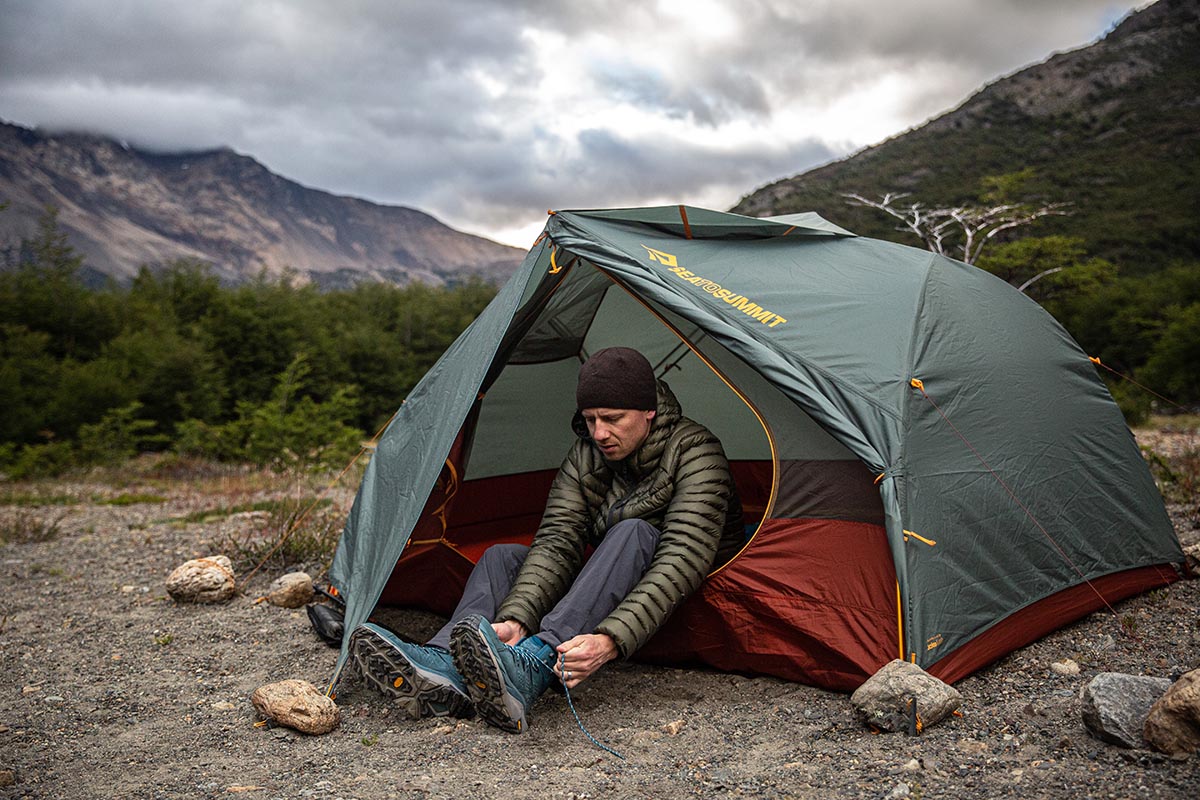
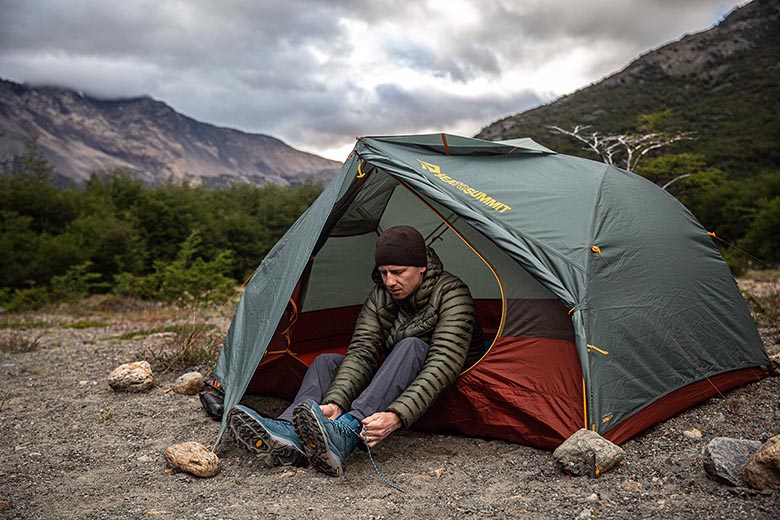
Price: $429
Packaged weight: 5 lbs. 3.6 oz.
Floor area: 31.2 sq. ft.
Capacities: 2P, 3P
What we like: Very roomy for two with quality and durable materials throughout.
What we don’t: Not a great price-to-weight ratio for committed backpackers.
See the Sea to Summit Ikos TR2
Still a relative newcomer to the tent market, Sea to Summit has added a third backpacking model for 2023: the Ikos. At $429 for the two-person capacity, it’s the most affordable of the bunch but retains the space-enhancing Tension Ridge pole and high-end look and feel of the pricier options. We tested the Ikos on a couple backpacking trips in southern Patagonia and think it’s a solid effort with a nice mix of durability, interior space, and user-friendliness. The biggest drawback is weight—and it’s a notable downside considering the price—but the Ikos nevertheless is a good option for short backpacking trips and the occasional car camping adventure. Below we break down our experiences with the Ikos TR2. To see how it stacks up to the competition, check out our article on the best backpacking tents.
Featuring the brand’s signature Tension Ridge pole design and a large footprint, Sea to Summit’s Ikos TR2 is a very spacious setup for two backpackers. The rectangular floor and symmetrical pole layout allow you to spread out and sleep head-to-foot to maximize roominess, and the stretched sidewalls make changing and moving around extremely easy. The highlight of the design is the unique ridge pole, which bends the sides up and away (most backpacking tents peak in the middle and slope down towards the sides). This gives the Ikos a decidedly open and airy feel that very few designs we’ve tested can match (REI’s Half Dome SL 2+ comes close). For spending significant time waiting out a storm—something we experienced on our trip to Patagonia—or if you simply prefer a non-claustrophobic setup, the Ikos’ livability is a real selling point.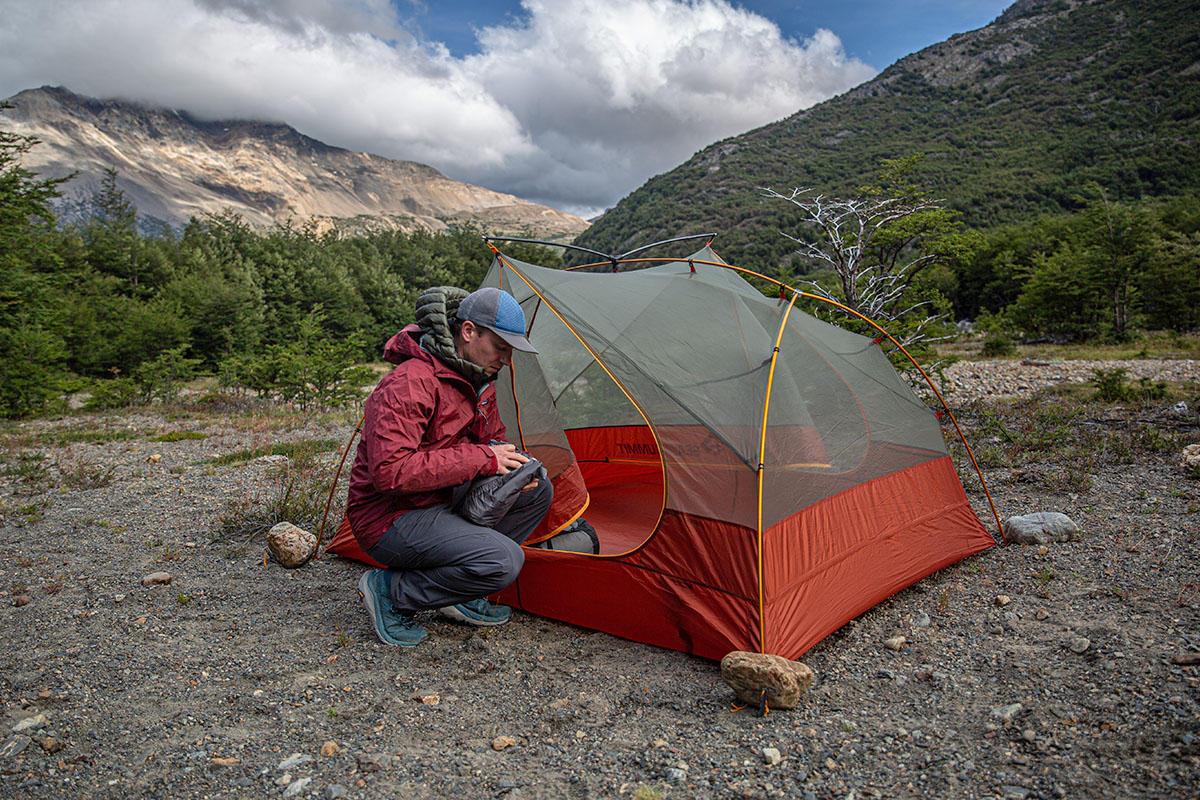
In terms of dimensions, the Ikos TR2 has a listed width of 53.1 inches and length of 84.6 inches. As with all backpacking tents, actual usable space is a bit less (these numbers are often taken at the stretched-out corners). In practice, we were able to comfortably fit one long/wide sleeping pad (78 x 25 in.) next to a standard 20-inch-wide mat, but it was a bit too snug to accommodate two of the 25-inch-wide models. Peak height at the middle is a respectable 41.3 inches, but that number only tells part of the story. The hubbed poles above each end mean the walls slope upward rapidly, so the actual open space inside the tent is truly expansive (peak height at the sides is over 42 in.). If you plan to mix in some car camping—in which case sizing up to the TR3 may be worth it—this extra wiggle room is a real benefit.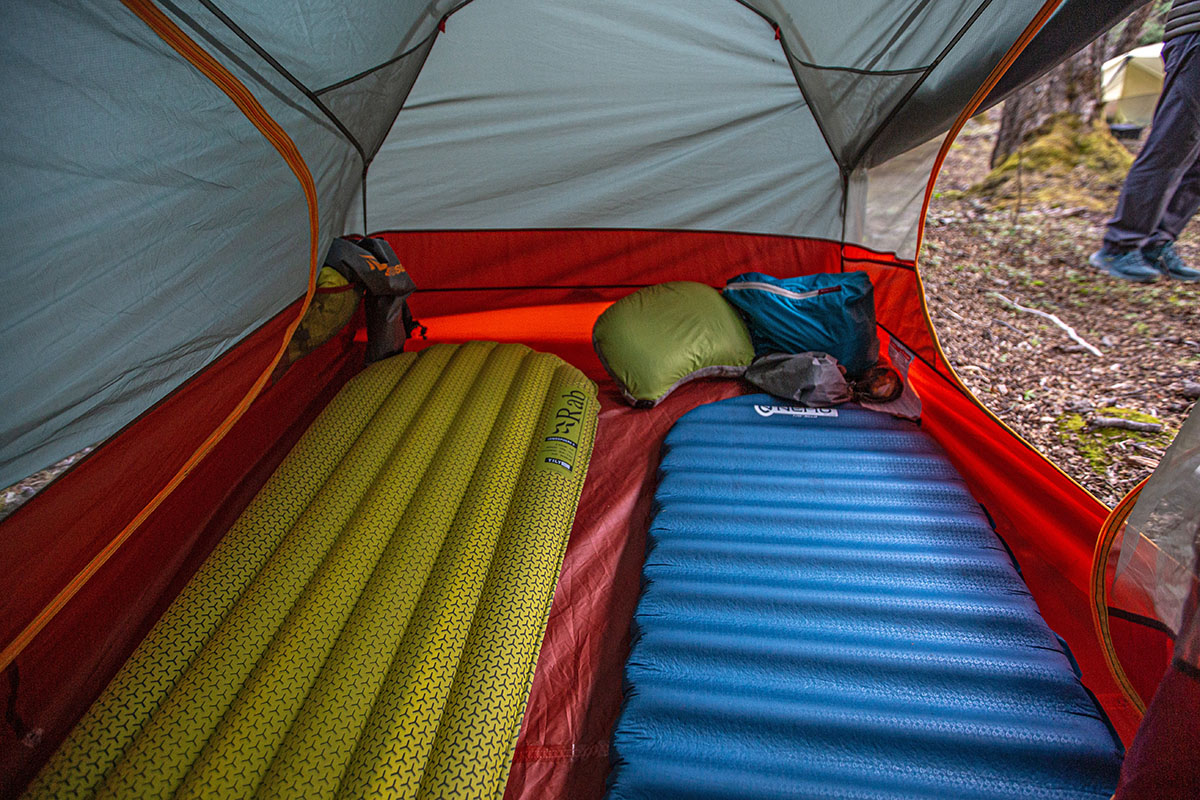
It’s clear that the Sea to Summit Ikos TR2 was built with interior space and durability in mind, so weight is not the tent’s strong suit. Committed backpackers will likely balk at the 5-pound-3.6-ounce packaged weight, especially considering you can spend $100 less on the REI Co-op Half Dome SL2+ and save around a pound in the process (half a pound if you bring the included footprint along). This cost-to-weight ratio is one of the Ikos’ biggest weak points. If you’re willing to sacrifice some roominess and toughness—and many backpackers are—alternatives like the $450 Big Agnes Tiger Wall UL2 (2 lbs. 8 oz.) and $399 REI Flash 2 (3 lbs. 4.2 oz.) are in a different stratosphere. Comparing the Ikos to Sea to Summit’s other models, the $599 Telos TR2 (3 lbs. 11 oz.) and $549 Alto TR2 (2 lbs. 15.3 oz.) also weigh significantly less.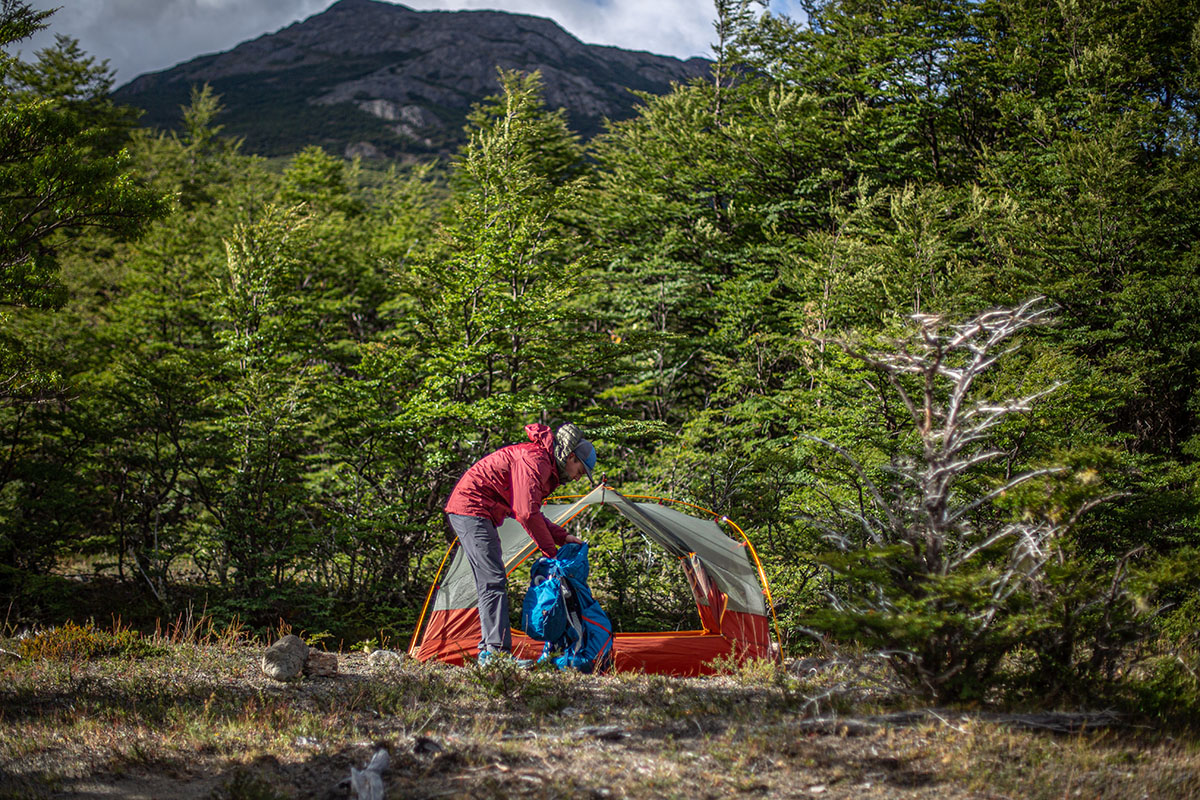
Packed size and weight often line up, and that’s mostly true for the Ikos. Its listed dimensions are 7 x 20 inches, which is on the large side for a backpacking tent (average packed size for a lightweight design is a couple inches smaller). That said, the included stuff sack features three sets of cinches along the side that allow you to compress the bag considerably smaller. This uncommon add-on proved to be very helpful when squeezing the Ikos inside a full backpacking pack. As with most tents, you have the option to separate the tent poles and stakes to make your packing life simpler on a multi-day trip. We mostly relied on this latter method and had no issues hauling the tent in our 60- and 65-liter packs.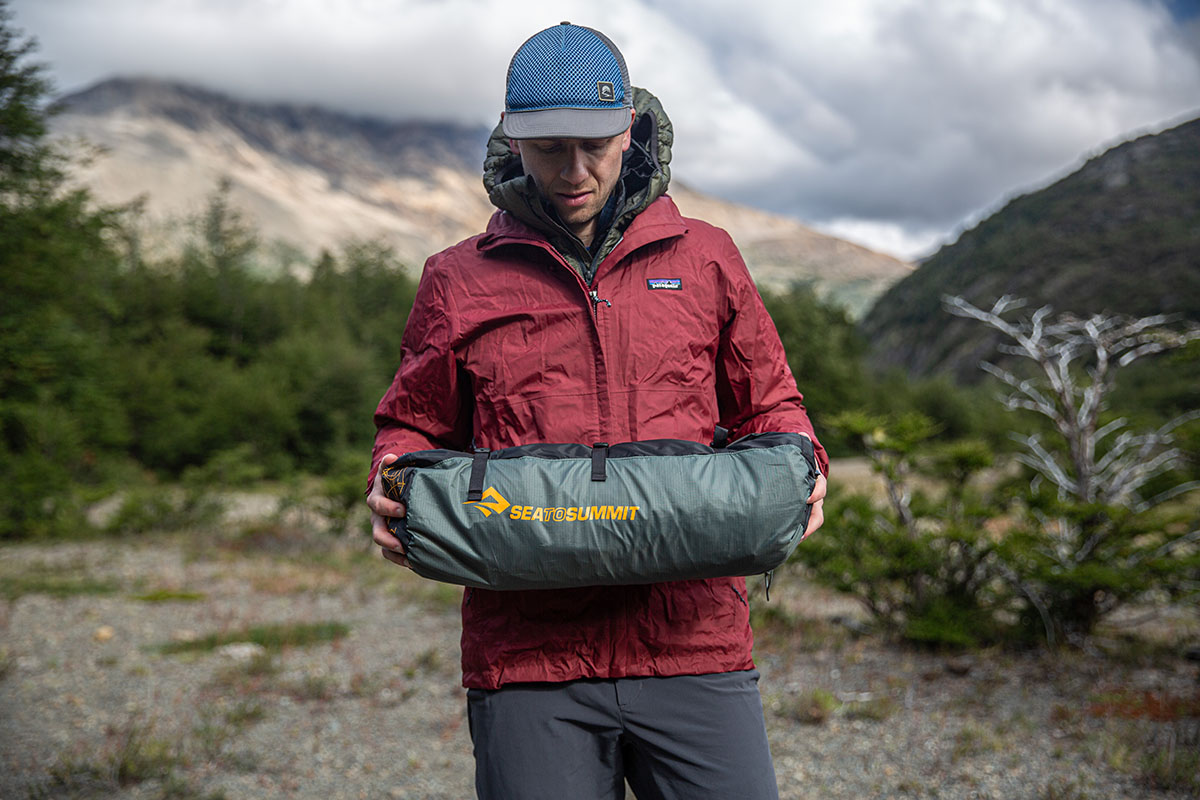
Transitioning from a weakness (weight) to a strength, the Sea to Summit Ikos TR2 is a true standout in terms of material quality and durability. Everything from the included compression sack to the DAC poles, metal hardware, and smooth-operating zippers have a premium look and feel. And Sea to Summit went all in on fabric durability, featuring thick 68-denier (D) polyester on the rainfly and floor (typical backpacking tents rely on thinner 15D to 40D fabrics). Additionally, the floor and fly have a Polyether Polyurethane (PeU) coating, which is known for its excellent water repellency and longevity.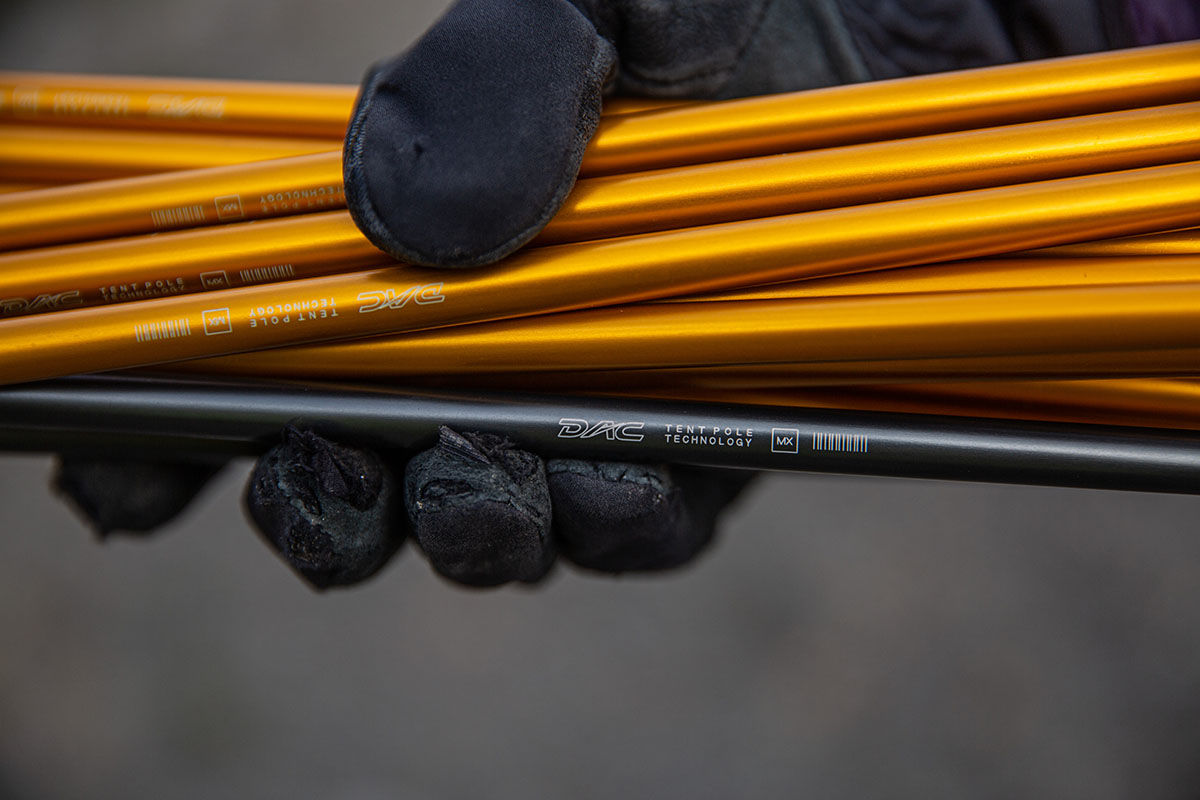
We camped directly on rocky surfaces—including at the foot of a glacier—and dealt with some significant wind and rain, and everything held up extremely well. Close inspection revealed no damage to the floor (something all our other backpacking tents experienced), and the sturdy polyester rainfly didn’t sag or lose its shape even during extended storms. If toughness and longevity are near the top of your wish list, our time with the Ikos makes for a strong case.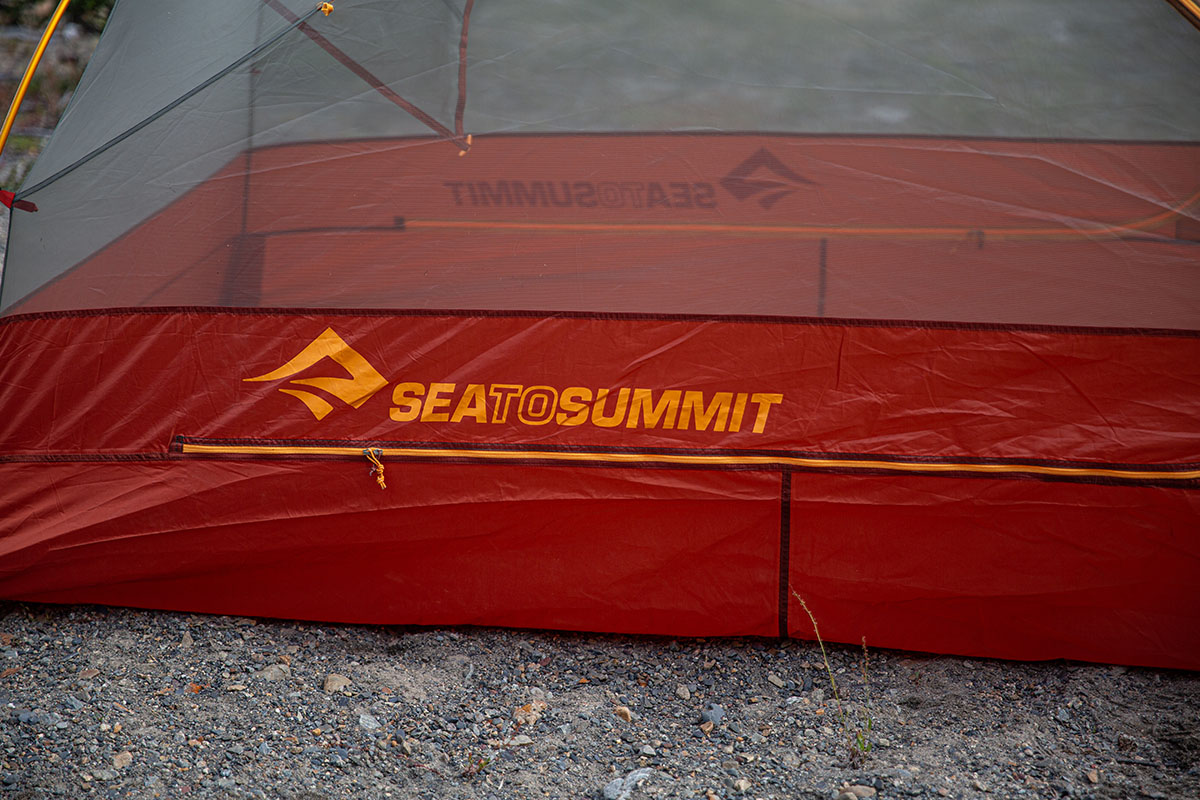
For obvious reasons, we aim for protected campsites on our trips to southern Patagonia, where high winds are a near-constant. But an ambitious overnight to the base of the Torre Glacier put us in a semi-exposed spot, which proved to be an over-the-top test of the Ikos’ weather protection. Through a sleepless night of extremely strong winds and blowing rain, a couple things stood out. First, the Ikos has a very strong structure thanks to its fully freestanding pole layout, plenty of guy-out points, and sturdy fabrics and DAC poles. In fact, it wound up being the only tent that didn’t suffer significant damage from the winds, which was truly an impressive feat. Additionally, the rainfly sits low to the ground, and the solid polyester extends a bit higher along the tent body (roughly 15 in. off the ground), which helps limit blowing dust and moisture from making their way inside.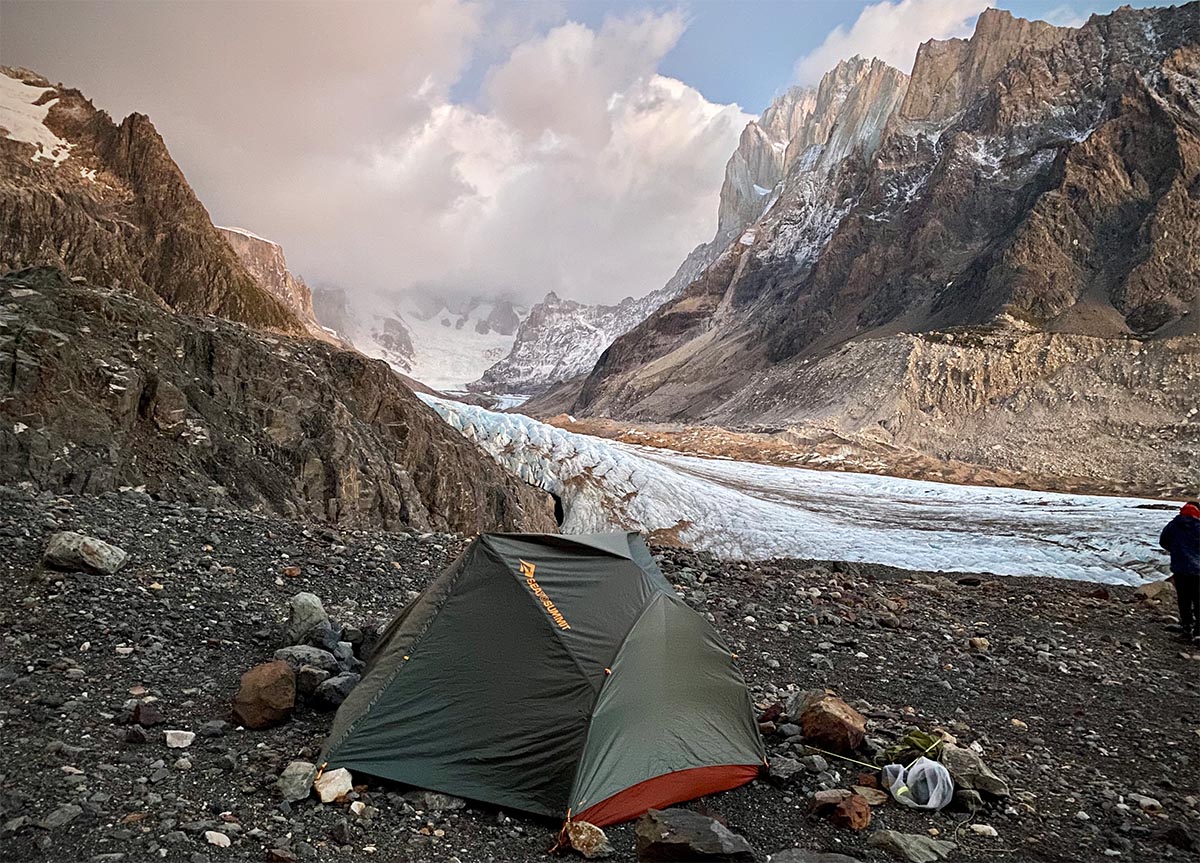
The second takeaway is a shared issue we’ve had with the other Sea to Summit tents: While the Tension Ridge design is a real boon for ventilation (more on this below), it leaves the tent a bit vulnerable in very heavy rain—and particularly when wind is involved. Even with the vent opening zipped closed, we experienced some leaking water that dripped inside. It’s not a deal breaker per se—the leaking was occasional, and the conditions were pretty wild—but we’d love to see a more water-resistant vent zipper or some form of upgraded protection in a future update. A final way to limit the issue is to position the tent so that the vents face away from the wind (they’re only on one side of the ridge pole), but we didn’t have that luxury with the swirling conditions in Patagonia.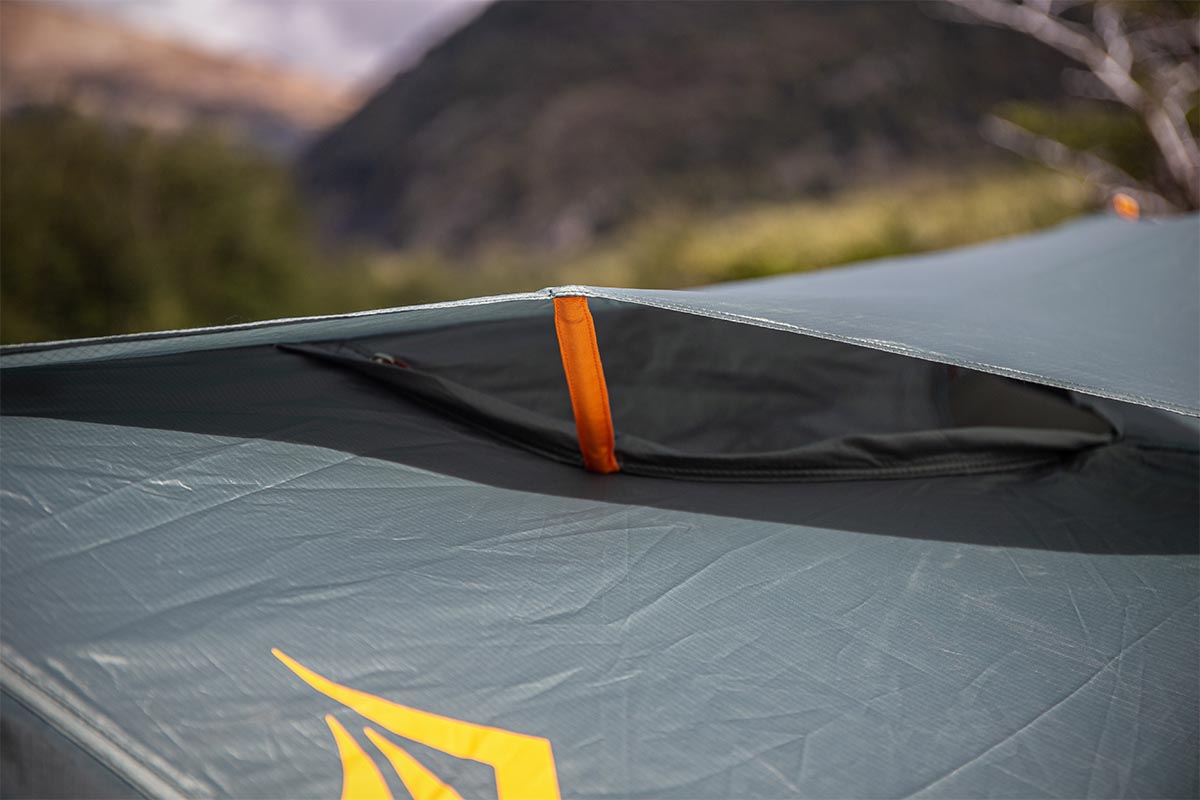
As I mentioned above, the Ikos’ Tension Ridge pole shape pays real dividends in terms of ventilation. I left the large fabric flap completely unzipped on non-stormy nights, and the generous opening let plenty of air flow through. Because of the raised ridge pole, there’s a lot of space between the tent body and the rainfly, which also helps minimize moisture buildup. The tent also features Baseline vents along the lower portion of the rainfly, which can be rolled up and tied off to allow air to enter from below (rolling the fly back all the way to the middle also makes for fantastic stargazing on clear nights). And finally, the all-mesh upper on the tent body and super roomy interior both pitch in to keep air moving. For humid or tricky wet-weather conditions that require a range of venting solutions, the Ikos’ design strikes us as very well sorted.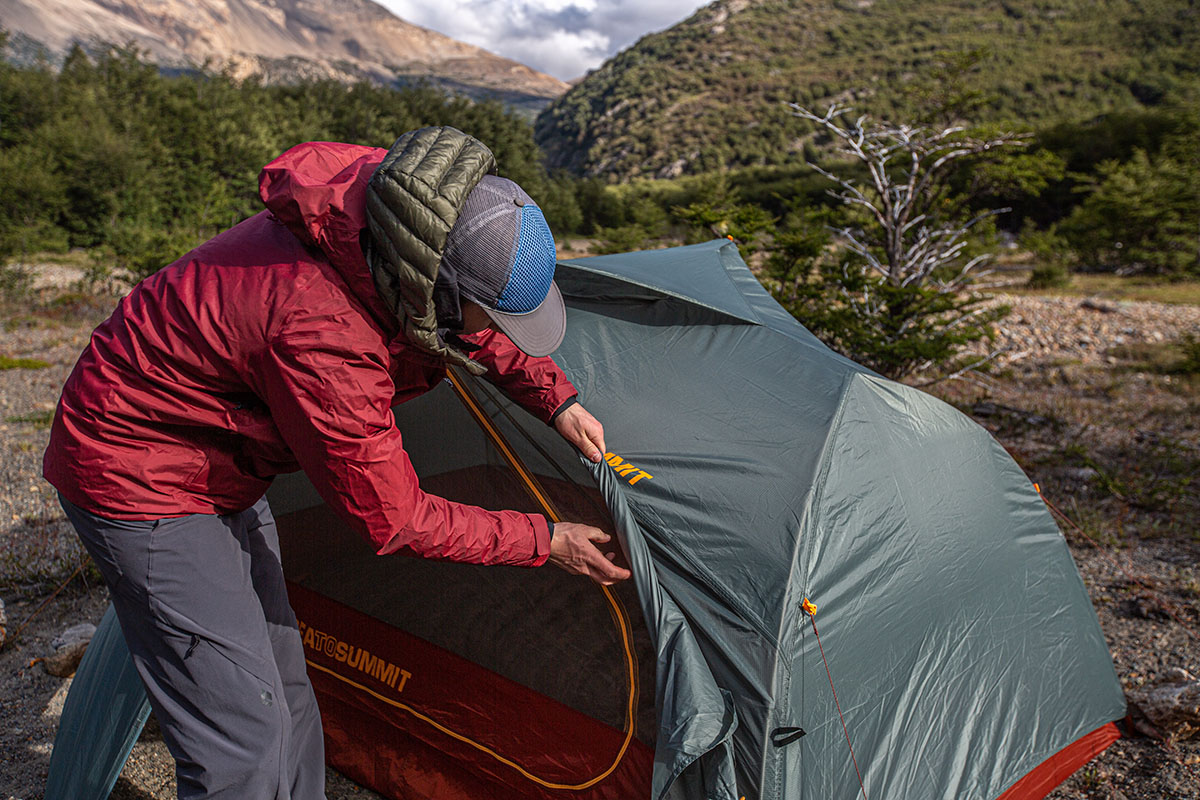
The Sea to Summit Ikos TR2 is intended for mixed car camping and backpacking use, so it’s no surprise that Sea to Summit prioritized organization. Inside, there are four pockets positioned on one end of the tent (presumably the head end): Two rectangular drop-in mesh pockets are situated low along the sides (roughly where your head would rest), which is nice for items you want to keep close at hand, while two triangular pockets are built into the mesh body above. Additionally, the tent includes a large mesh gear loft that can be attached to loops along the roof, which I found very useful for drying out wet clothing overnight. My only nitpick with the storage layout is that the four main pockets are all located at one end of the tent. If you like to sleep head-to-foot, one person misses out on easily accessible storage.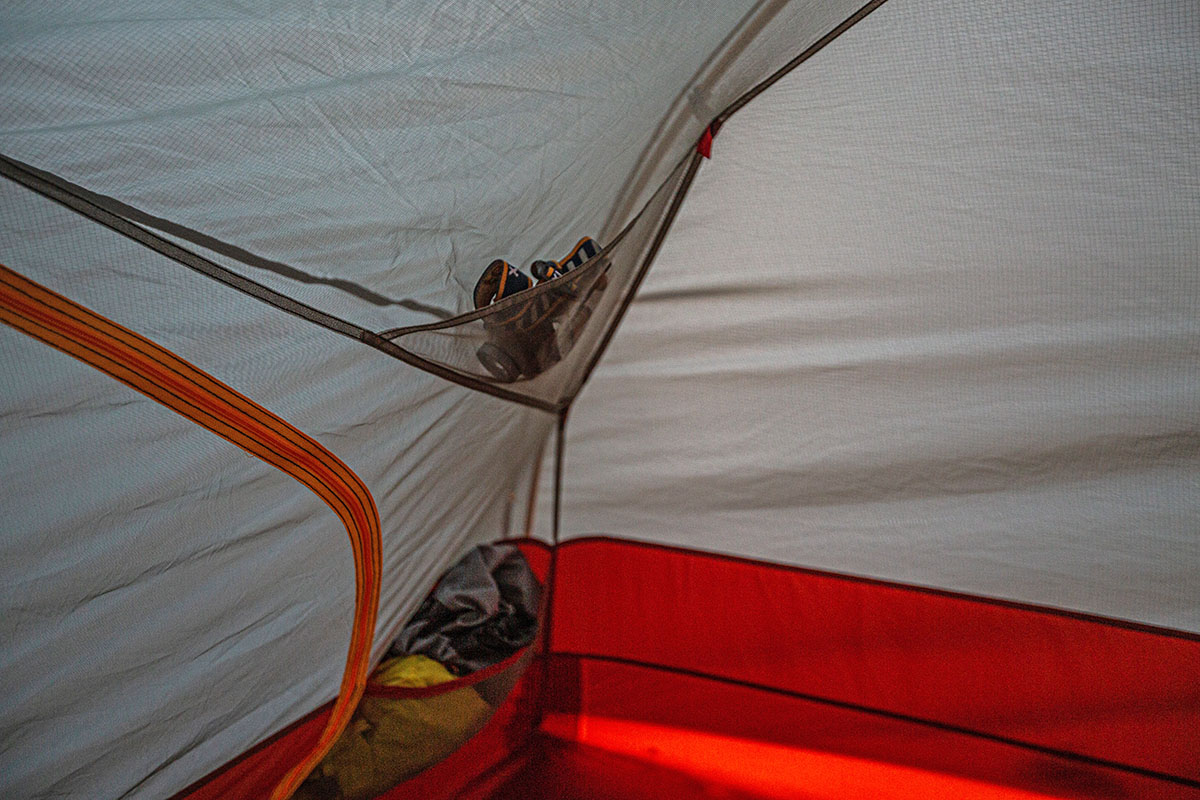
Shifting outside the tent body, the two-door layout gets you a corresponding two vestibules along the sides of the tent. Total area is 17.8 square feet, which is a little above average in the backpacking market. In use, the vestibules offered sufficient room to fully protect my pack and hiking boots on one side (and another editor’s on the other), although it was a somewhat tight squeeze to keep everything safe from the heavy rain. Given the Ikos' hybrid intentions, we would have preferred a little more covered space. The good news is that the raised ridge pole gives the vestibule a tall peak height, which makes getting in and out of the tent a little easier.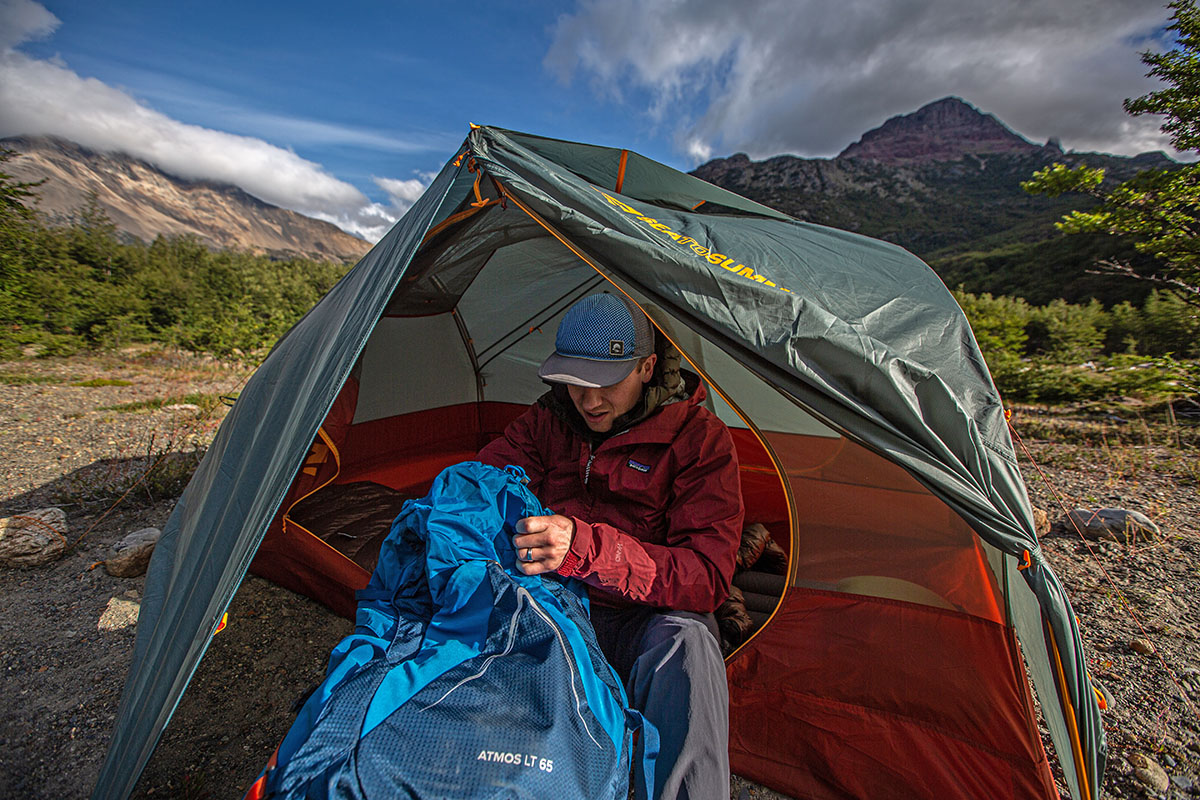
With a symmetrical shape and freestanding pole structure, the Sea to Summit Ikos TR2 is very quick and easy to set up, even if it’s your first time. The hubbed pole system is all one piece, so there’s no risk of losing a ridge pole, and the attachments for the poles, fly, and stakes are all very intuitive. It’s also clear Sea to Summit put a lot of thought into the design, as there are nice touches like a webbing loop to pull the rainfly into place over the ridge pole and minimal use of plastic (most of the hardware is metal). Another positive is that you can set up the fly first (and take it down last), which is handy for protecting the inner tent if it’s raining. Finally, there are a variety of additional setup options, including a fly-only pitch and a “hangout mode,” which amounts to a low-profile, semi-open shelter for up to four people.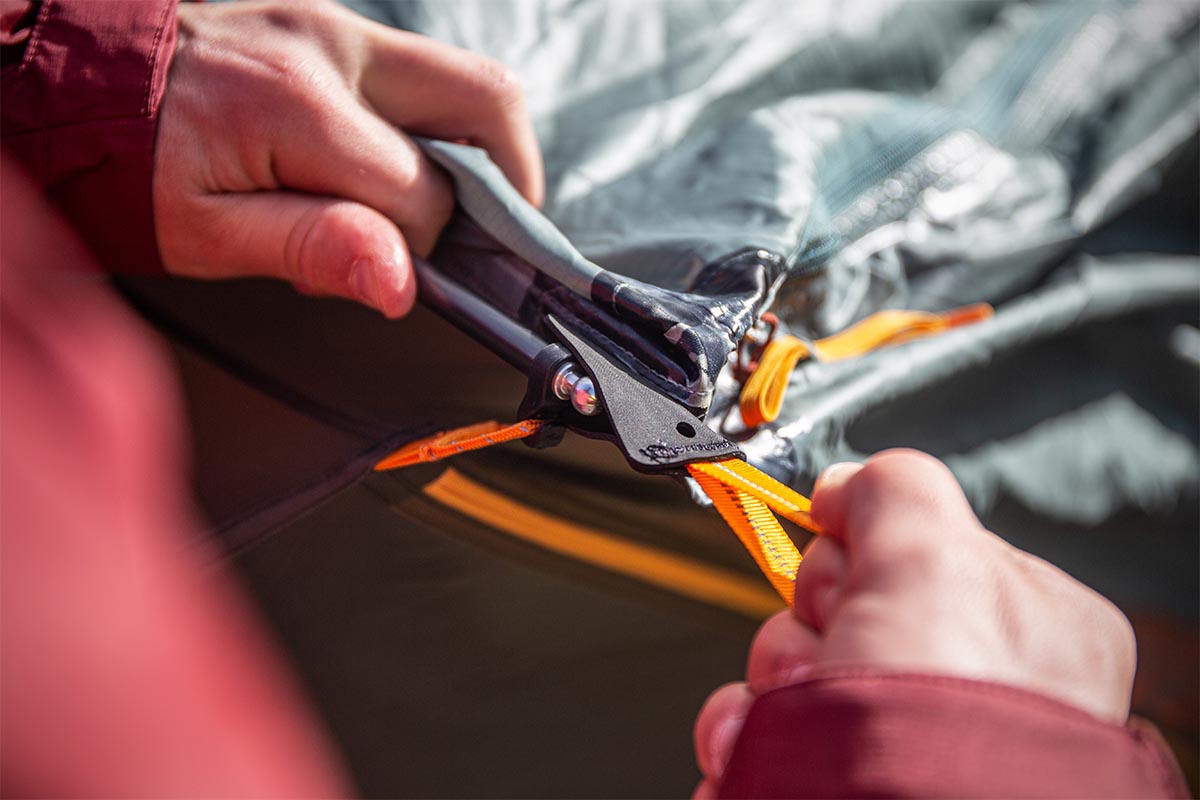
It’s great to see the momentum in the industry to more sustainable practices, and the Ikos is a good reflection of the modern tent market. First, the tent’s DWR coating is PFC-free, which means it’s made without the use of harmful perfluorocarbons. Further, like Sea to Summit’s Telos and Alto models, the Ikos’ poles are made using their green anodization process, which require less water usage during production. Finally, the Ikos TR2 is covered by Sea to Summit’s lifetime warranty against defects in workmanship and materials, which is a nice dose of added assurance should you encounter an issue (we’re big proponents of repairing old gear over buying new whenever possible).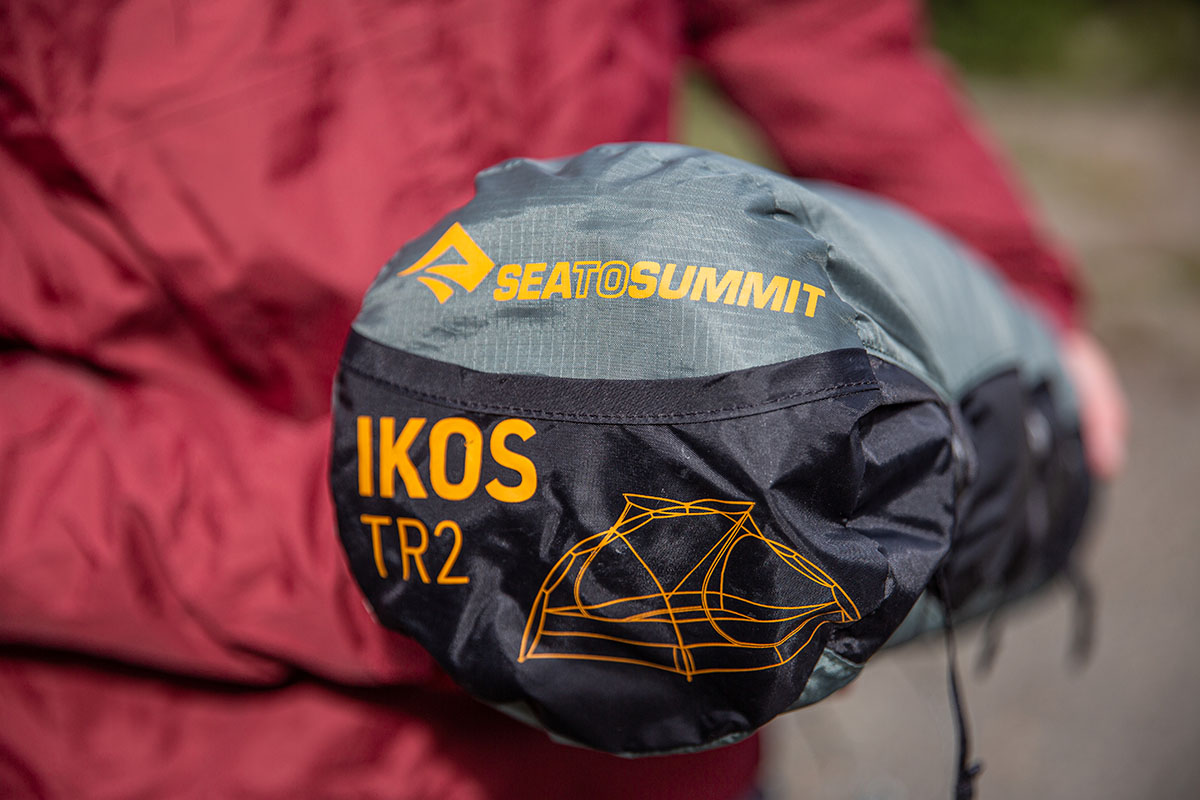
We tested the Ikos TR2 for this review, and it’s also sold in a larger three-person capacity for $100 more. Stacked up against the two-person model, the Sea to Summit Ikos TR3 is around a pound and a half heavier at 6 pounds 15.7 ounces all in, has a listed packed size of 8 x 20 inches (compared to 7 x 20 for the Ikos TR2), and offers a nice boost in livability with roomier dimensions all around. These include a 48.4-inch peak height, 49.2-square-foot floor area, and 24.5 square feet of vestibule space. The rest of the design is largely identical, including a fully freestanding build that’s very quick and easy to pitch, multiple setup options, and the same Tension Ridge pole design that we love.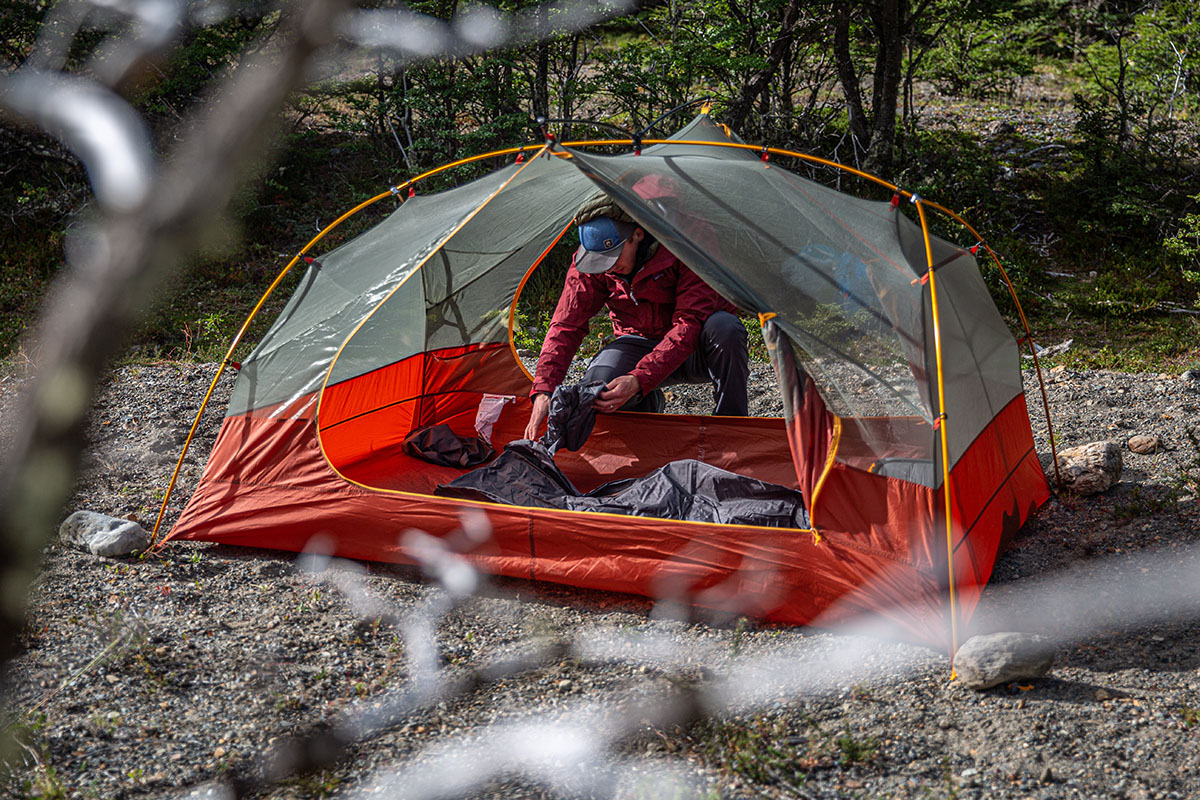
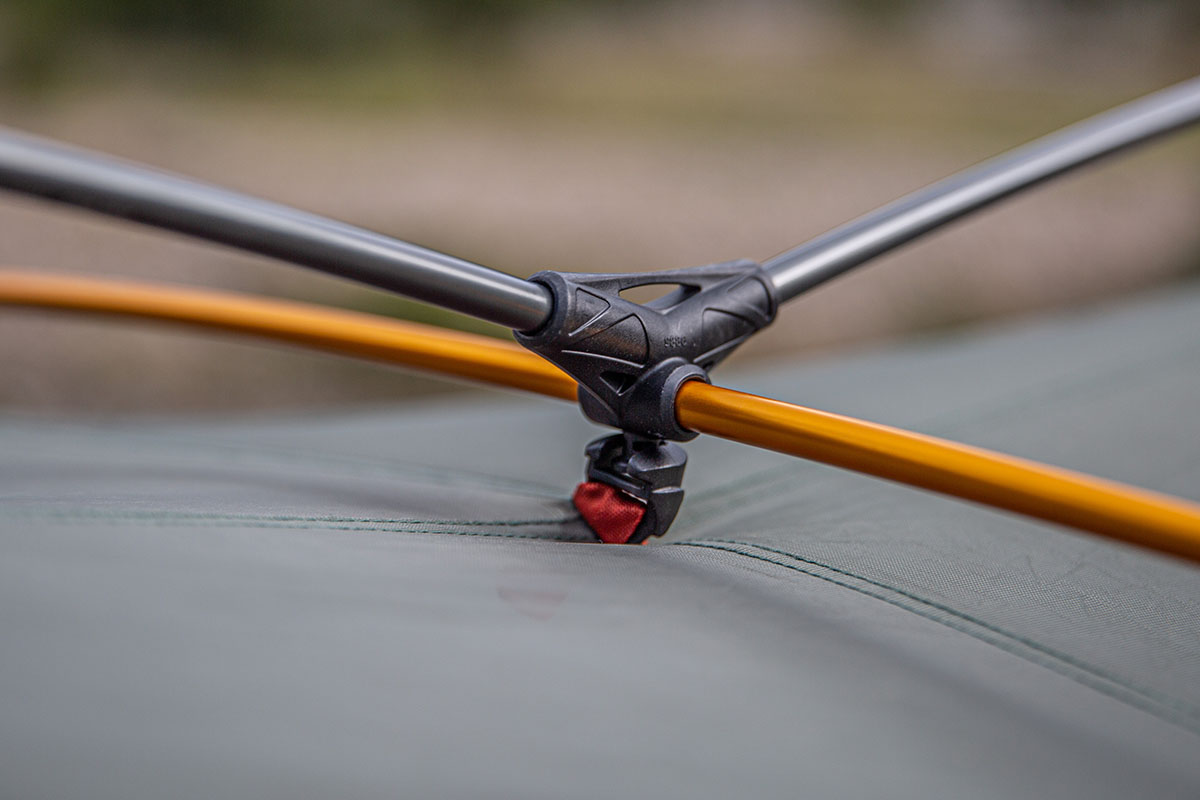
| Tent | Price | Weight | Floor | Area | Height | Door(s) | Capacities |
|---|---|---|---|---|---|---|---|
| Sea to Summit Ikos TR2 | $429 | 5 lb. 3.6 oz. | 68D | 31.2 sq. ft. | 41.3 in. | 2 | 2P, 3P |
| REI Co-op Half Dome SL2+ | $329 | 4 lb. 11.5 oz. | 40D | 33.8 sq. ft. | 42 in. | 2 | 2+P, 3+P |
| NEMO Aurora 2P | $300 | 5 lb. 7 oz. | 68D | 31.8 sq. ft. | 44 in. | 2 | 2P, 3P |
| NEMO Dagger OSMO 2P | $530 | 4 lb. 2 oz. | Unavail. | 31.3 sq. ft. | 42 in. | 2 | 2P, 3P |
| Sea to Summit Telos TR2 | $599 | 3 lb. 11 oz. | 20D | 28 sq. ft. | 43.5 in. | 2 | 2P, 3P |
Sea to Summit’s Ikos TR2 bridges the gap between lightweight backpacking tents and luxurious car camping designs, but it’s not the best value considering its heft. Enter REI Co-op’s Half Dome SL2+, which costs $100 less than the Ikos, checks in about a pound less (comparing like-for-like without the REI's included footprint), and boasts a larger 33.8-square-foot floor area. You also get more vestibule space (22.5 sq. ft. total) and a similar 42-inch peak height, although the Ikos’ Tension Ridge pole goes a long way toward opening up the interior. The Sea to Summit gets the edge in durability and material quality with its thicker 68D floor and rainfly—compared to 40D and 30D for the REI, respectively—and we love the premium touches like the cinches on the stuff sack to compress the Ikos down further and the ability to pitch the fly first if it’s raining. In the end, the Ikos is a thoroughly premium design, but it’s hard to justify the sizable price jump over the lighter Half Dome.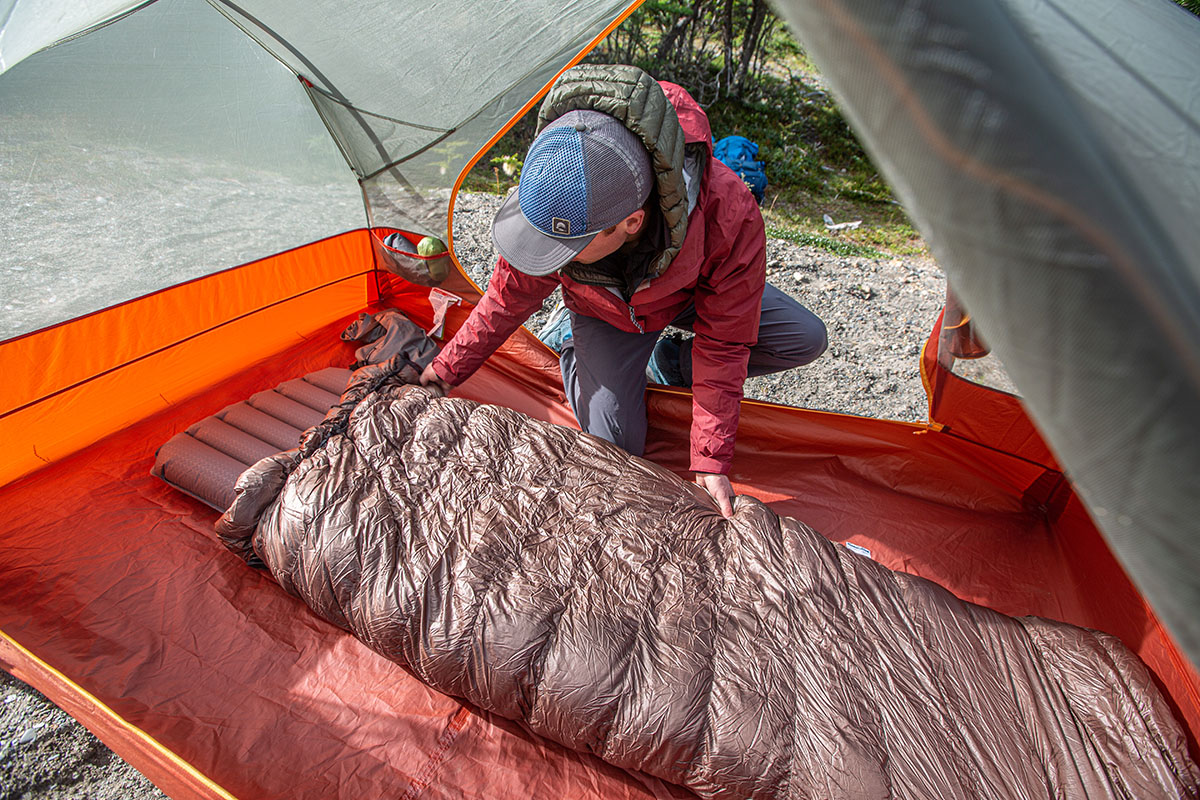
The Ikos doesn’t have many direct competitors, but another crossover backpacking/camping design to have on your radar is NEMO’s Aurora 2P. Like the Sea to Summit, the NEMO is super roomy inside with a large footprint (31.8 sq. ft.), generous 44-inch peak height, and hubbed pole design that bends the ends upwards even more aggressively than the Ikos. Additionally, the Aurora is similarly durable with 68D floor and rainfly fabrics and weighs around the same at 5 pounds 7 ounces (with the footprint included). The Ikos is a little more thoughtfully built with some minor material and feature upgrades, but the Aurora will save you a considerable $129 with no major performance drawbacks, which is enough to earn our endorsement.
Another NEMO design to consider is their Dagger OSMO 2P, which is considerably lighter than both the Aurora and Ikos at 4 pounds 2 ounces all in. Interior space is also very competitive among the lightweight backpacking tent competition with a 31.3-square-foot interior and tall 42-inch peak height, although the Ikos gets the edge in spaciousness with its Tension Ridge design and near-vertical walls. The Dagger isn’t far off, however, and is more versatile for backpacking thanks to its lighter and more packable build (for more, see our Dagger OSMO 2P review). The Sea to Summit will save you around $100 and crosses over better for occasional car camping use, but the Dagger wins out for committed backpackers who regularly embark on multi-day trips.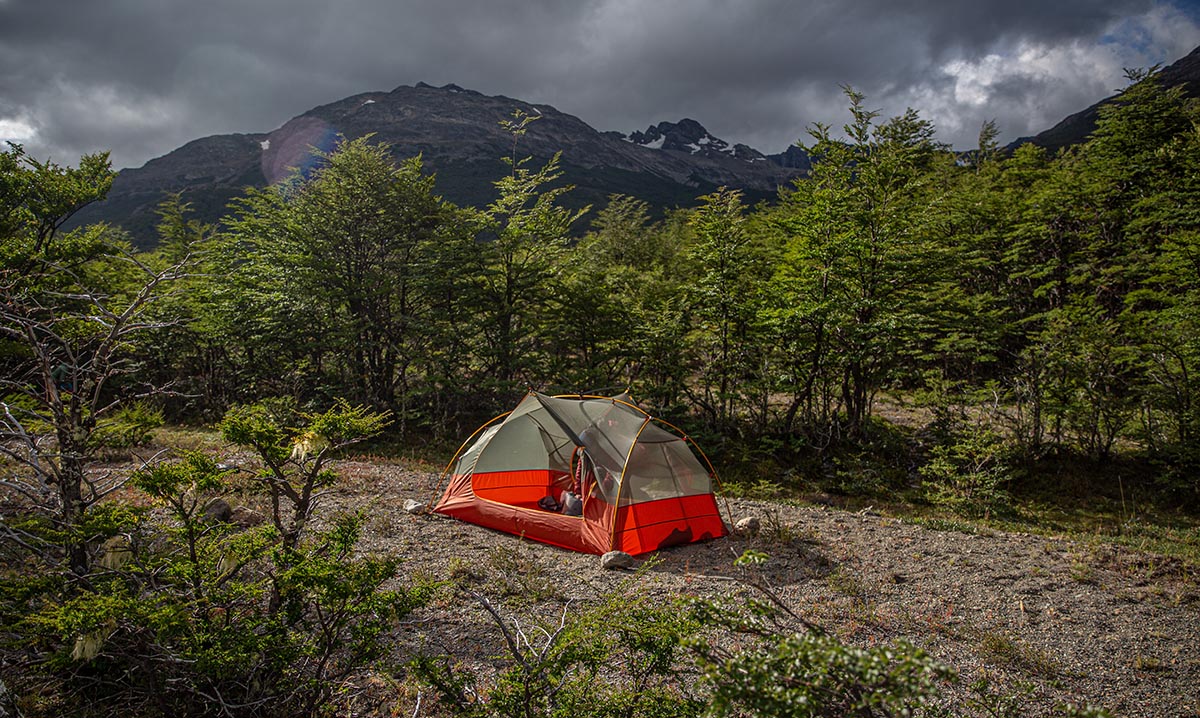
Last but not least is an in-house competitor to the Ikos: Sea to Summit’s Telos TR2. Like the NEMO Dagger, the Telos is more of a backpacking design than a crossover option like the Ikos, which comes with several benefits. First are weight and packability: At 3 pounds 11 ounces all in, the Telos is the lightest competitor here by a sizable margin and compresses down to a competitive 5 x 19 inches in its stuff sack. Sea to Summit also retained a very generous 43.5-inch peak height (thanks in large part to the same Tension Ridge pole design), and the vestibules are a little bigger at 19.5 square feet total. That said, the Telos has a non-symmetrical floor plan that tapers fairly aggressively at the foot end, uses noticeably thinner and more fragile fabrics (including a 20D floor and 15D fly), and costs a steep $599. Again, the price jump might be worth it for those who head into the backcountry frequently, but casual backpackers can save a significant $170 with the Ikos while getting a sizable upgrade in durability.